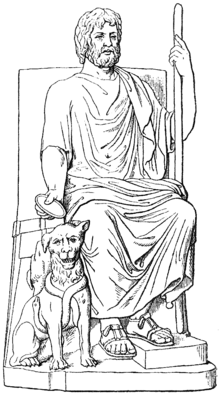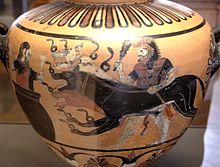Cerberus

Cerberus is the name given to the entity which, in Greek and Roman mythology, is a multi-headed dog which guards the gates of Hades, to prevent those who have crossed the river Styx from ever escaping. Cerberus featured in many prominent works of ancient Greek and Roman literature and in works of both ancient and modern art and architecture. As with most creatures from classicial mythology, the depiction and background surrounding Cerberus often differed across various works by different authors of the era, the most notable difference being his number of heads; while most sources describe or depict three heads, others show him with two, a lesser number show a variable amount, sometimes as high as 50.
Etymology
The name "Cerberus" is a Latinised version of the greek word Kerberos, meaning "demon of the pit".[1] The first use of the word in association with the dog it is now applicable to is unknown,[2][3] however mythologers have speculated that his name was given to him in the city of Trikarenos in Phliasia.[4] Classical mythologers speculated [4]
Mythology


Cerberus was the son of Echinda, a hybrid half-woman, half-serpent and Typhon, a fire-breathing giant whom even the Olympian gods feared. His brother is Orthrus, always depicted as a two-headed hellhound.[5] The common depiction of Cerberus in Greek mythology and art is as having three-heads, a mane of live serpents (similar to Medusa's hair) and a serpent's tail. In most works the three-heads each respectively see and represent the past, the present and the time yet to come, while other sources suggest the heads represent birth, youth and old age.[6] Each of Cerberus' heads are said to have an appetite only for live meat and thus allow the spirits of the dead to freely enter the underworld, but allow none to leave.[7] Cerberus was always employed as Hades' loyal watchdog, and guarded the gates that granted access and exit to the underworld (also called Hades).[8]
Literature
Cerberus featured in many prominent works of Greek and Roman literature, most famously in Virgil's Aeneid, Peisandros of Rhodes' epic poem the Labours of Hercules, the story of Orpheus in Plato's Symposium,[1] and in Homer's Iliad, which is the only known reference to one of Hercules' labours which first appeared in a literary source.[9]
The depiction of Cerberus in classical literature is relatively consistent between different works and authors, the common theme of the mane of serpents is kept across works, as is the serpent's tail, most literary works of the era describe Cerberus as having three heads with the only notable exception being Hesiod's Theogony in which he had 50 heads.[10]
Most occurrences in ancient literature revolve around the basis of the threat of Cerberus being overcome to allow a living being access to the underworld; in the Aeneid Cerberus was lulled to sleep after being tricked into eating drugged honeycakes and Orpheus put the creature to sleep with his music. The task of capturing Cerberus was the final labour assigned to Hercules by King Eurystheus, in recompense for the killing of his own wife and children after he was driven insane by Hera, and therefore was the most dangerous and difficult. In the traditional version, Hercules would not have been required to capture Cerberus, however Eurystheus discounted the completion of two of the tasks as Hercules had received assistance. In the original retelling, Hercules first asked Hades for Cerberus and was told he could take him if he could overpower him, in which he succeeded. Cerberus was returned to Hades are the task was completed.[5]
Art

Numerous references to Cerberus have appeared in ancient Greek and Roman art,[11] found in archaeological ruins and often including in statues and architecture, inspired by the mythology of the creature. Cerberus' depiction in ancient art is not as definitive as in literature; the poets and linguists of ancient Greece and Rome mostly agreed on the physical appearance (with the notable exception in Hesiod's Theogony in which he had 50 heads).[10] His depiction in classical art mostly shows the recurring motif of serpents, but the number of heads differs.[12] A statue in the Galleria Borghese depicts Cerberus with three-heads sitting by the side of Hades, while a bronze sculpture depicting Hercules' twelfth labour shows the demi-god leading a two-headed Cerberus from the underworld. The majority of vases depicting the twelfth task also show Cerberbus as having two heads.[13] Classical critics have identified one of the earliest works of Cerberus as "the most imaginative", that being a Laconian vase created around 560 BC in which Cerberus is shown with three-heads and with rows of serpents covering his body and heads.[14]
Explanations
There have been many attempts to explain the depiction of Cerberus. Greek philosopher, Heraclitus, claimed that Cerberus had two pups which were never away from their father, as such Cerberus was in fact a normal (however very large) dog but artists incorporating the two pups into their work made it appear as if his two children were in fact extra heads.[15] Classical historians have dismissed Heraclitus' explanation as "feeble".[4] Mythologers have speculated that if Cerberus was given his name in Trikarenos it could be interpreted as "three karenos".[4]
References
- ^ a b Lindemans, Micha. "Cerberus". Encyclopedia Mythica. Retrieved 2008-10-21.
- ^ Harper, Douglas. "Cerberus". Online Etymology Dictionary. Retrieved 2008-10-21.
- ^ "Woodhouse's English-Greek Dictionary". University of Chicago Library. Retrieved 2008-10-21.
- ^ a b c d Bloomfield, Maurice (2003). Cerberus the Dog of Hades. Kessinger Publishing. p. 7. ISBN 0766130207.
- ^ a b "Hercules' Twelfth Labor: Cerberus". Perseus Project. Retrieved 2008-10-21.
- ^ Bloomfield, Maurice (2003). Cerberus the Dog of Hades. Kessinger Publishing. p. 8. ISBN 0766130207.
- ^ Allardice, Pamela (1991). Myths, Gods & Fantasy. ABC-CLIO. p. 52. ISBN 0874366607.
- ^ Guerber, Helene (2003). Myths of Greece and Rome. Kessinger Publishing. ISBN 0766148564.
- ^ Homer. "8". Iliad. p. 366–369.
- ^ a b Hesiod. Theogony. p. 310.
- ^ Hegeler, Edward (1904). The Monist. Hegeler Institute. p. 524.
- ^ Bloomfield, Maurice (2003). "Cerberus in Classical Art". Cerberus the Dog of Hades. Kessinger Publishing. p. 3. ISBN 0766130207.
- ^ Bloomfield, Maurice (2003). "Cerberus in Classical Art". Cerberus the Dog of Hades. Kessinger Publishing. p. 4. ISBN 0766130207.
- ^ Lenardon, Robert (1997). A Companion to Classical Mythology. Oxford University Press. ISBN 0195147251.
{{cite book}}: Unknown parameter|coauthors=ignored (|author=suggested) (help) - ^ Heraclitus. Περὶ ἀπίστων. p. 331.
